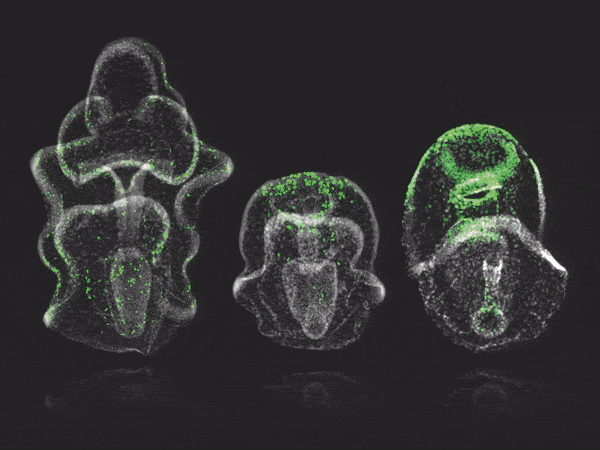Finding Common Ground in the Regeneration Process
Across the animal tree of life, the process of regeneration is limited to certain groups of animals. Even within each major grouping, only certain species can regenerate, and this may be further limited to particular structures or tissue types. Sea stars are able to undergo whole-body regeneration, including at their larval stage: once bisected, each half can regrow the missing half. But how is this achieved? And how similar is sea star regeneration to other distantly related species that undergo whole-body regeneration. In a recent paper1 published in BMC Biology, Veronica Hinman, professor of biological sciences, and members of her lab – Greg Cary, Andrew Wolff, Olga Zueva and Joe Pattinato – examined regeneration in sea star larvae to better understand how this process works.
Using a variety of molecular biology and imaging techniques, the Hinman lab described several events that occur during regeneration, including the formation of a wound, the re-specification of larval axes, the re-proportioning of tissues to produce a larva of the correct size, and the clustering of proliferating cells proximal to the wound site. Not only were these events identified, the researchers also determined their temporal order, with wound healing happening first, followed by axis re-specification and re-proportioning of tissues, ending with proliferative cells localizing the wound site. These outlined processes have been observed in other model species of regeneration, suggesting that these aspects of regeneration are conserved across metazoans.
Having uncovered these mechanisms of achieving regeneration, the Hinman lab sought to discover the genes that underlie them. Using RNAseq, they uncovered differentially expressed genes during regeneration in comparison to uncut larvae. These genes were then grouped based on their expression profile into distinct clusters. Looking closer at the clusters, the lab identified genes that are expressed similarly in both larval segments, indicating genes globally involved in regeneration. Early in regeneration, they found genes implicated in immune system function, as well as MAPK signalling, corresponding to wounding happening at this time point. Later in regeneration, at the time they saw an increase in cell proliferation, genes involved in DNA replication and the cell cycle were upregulated. Thus, the RNAseq dataset confirmed the genes regulating the processes that were previously outlined.
Previous studies have examined the transcriptome during regeneration of other species, but no study thus far has done a comparison at this level across the animal tree. To detect similarities between regeneration in larval sea stars and other species, the authors compared their transcriptome to two other regenearting species, Hyda and the planarian flatworm, in order to identify orthologous genes with comparable expression patterns. Using this approach, they were able to identify genes and processes that are shared across these distantly related species.
This study suggests that there are common processes underlying regeneration across even very distantly related animals. This provides potential to understand common mechanisms to determine whether these can be induced in animals, such as ourselves, which have little or no natural capacities to regenerate.
By Andrew Wolff
